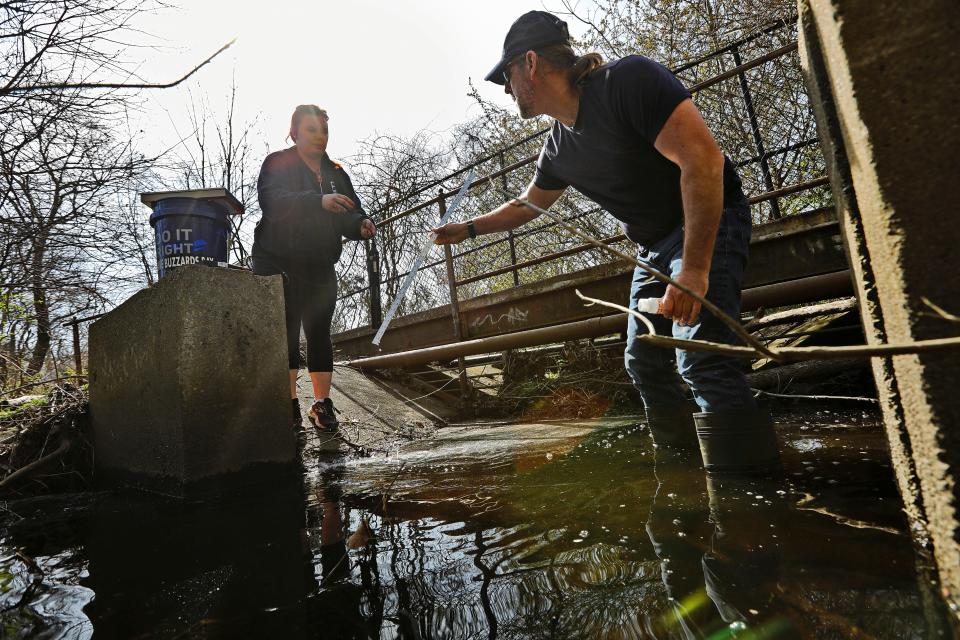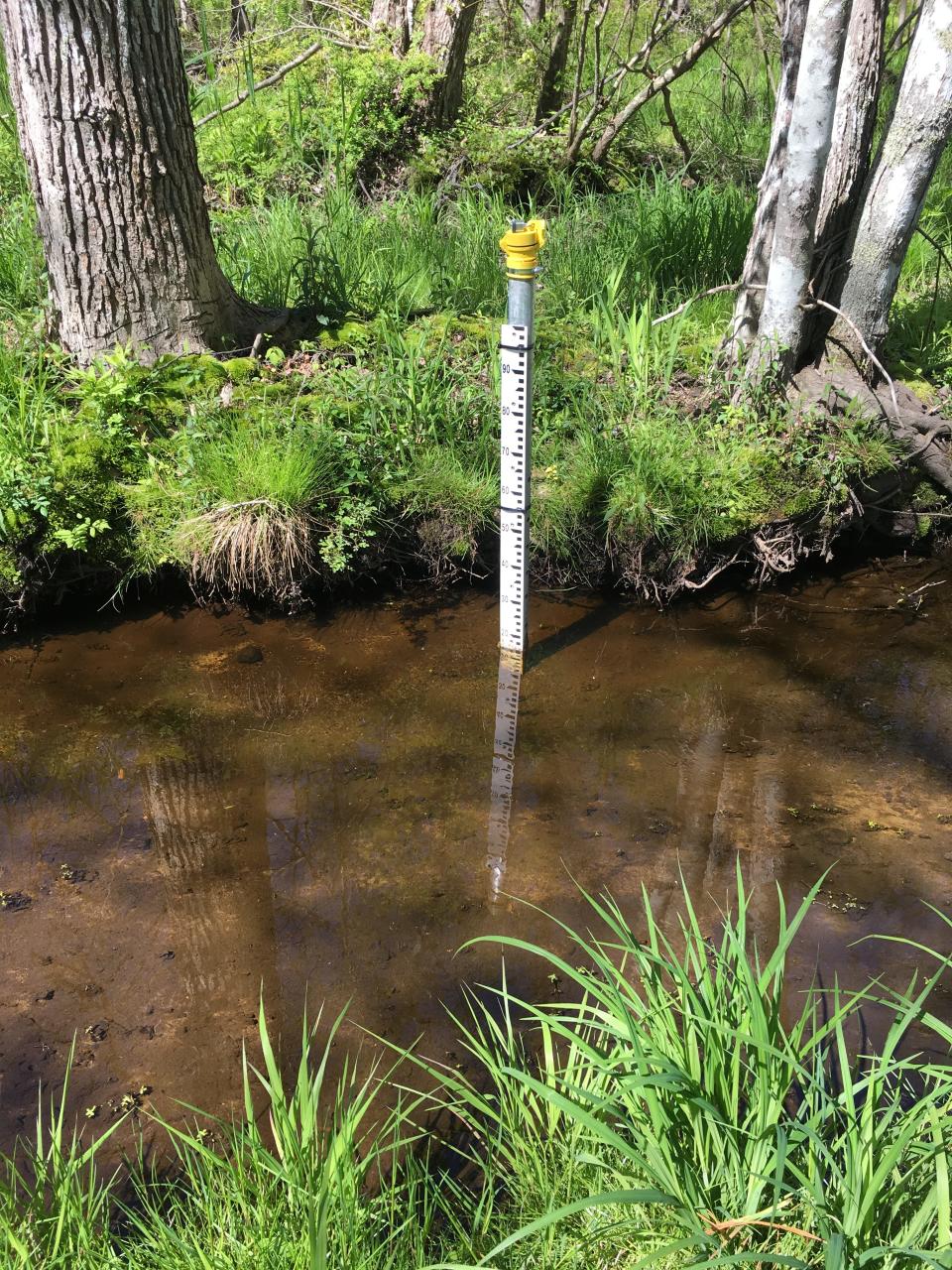Issues with this brook are causing flooding at New Bedford and Dartmouth homes. Here's why.
NEW BEDFORD/DARTMOUTH — Hidden from view, invisible to the drivers passing over it on Hawthorne Street and other streets that drain directly into it, lies Buttonwood Brook.
Daniel Goulart, the Buttonwood-to-Bay project manager for the Buzzards Bay Coalition and a Friends of Buttonwood Park board member, knows what lies beneath, and what doesn’t.
Pick up a rock in a typical brook to see what lives underneath it and you’ll find fly larvae, snails and slugs and other slippery creatures. That’s not the case when looking under most rocks in Buttonwood Brook.

Goulart has been on a fact-finding mission conducting water testing at 14 sites along Buttonwood Brook from where it starts just south of Hathaway Road all the way to where it empties into Padanaram Harbor.
Summer's coming: The state spent $5 million to improve Horseneck Beach, campground — here's what to expect
The past 150 years of development and 150 years of land use changes have fundamentally altered the Buttonwood Brook Watershed, degrading the water quality to the point of being dangerous for public health and restricting its ability to absorb large rain events.
“What used to be a watershed dominated by infiltration of water into the soils and the feeding of the brook from underground has transitioned to a runoff watershed,” he said. “Ninety percent of the water that’s feeding into this brook at this point is coming off of the streets and parking lots and roofs at higher temperatures and carrying more and more pollutants and sediments.”
He said it’s not just about pollution in the brook, it’s about dealing with a brook that’s impaired in its own ability to manage the volume of water that’s now coming into it and leading to flooding into people’s property and along the length of the brook.
Hot properties: Thinking about a summer rental in the SouthCoast? Here's why you might be too late.
“We’re going to see more flooding events, more issues with personal and public property being impaired, and it’s impacting the waterways downstream on Padanaram Harbor, a critical part of our tourism economy but also commercially viable fisheries, recreational fisheries and just people’s ability to swim in Apponagansett Bay in the future,” he said.
Buttonwood Brook goes right through people’s backyards in some places so he worked with the conservation commissions of New Bedford and Dartmouth to send letters to all abutters notifying them of the restoration project.
Goulart grew up in New Bedford and remembers seeing all the turtles, frogs and other amphibians in Buttonwood Brook. That’s not been the case while walking the entire length of the brook and all its tributaries – all 8.5 miles – to assess its physical condition and identify sources of pollution.
These activities will continue throughout the year and will provide baseline information that is critical to identifying and prioritizing areas in need of restoration. He would ultimately like to create opportunities for public access like he had growing up.

The five-year project is funded by the federal Environmental Protection Agency’s Southeast New England Program, a watershed program that focuses on small local watersheds including Buzzards Bay.
Project partners include the city of New Bedford, the town of Dartmouth, the Buzzards Bay National Estuary Program, Buttonwood Park Zoo, Friends of Buttonwood Park, Woodwell Climate Research Center, Marine Biological Lab, Woods Hole Oceanographic Institution and the Dartmouth Natural Resource Trust.
Property Transfers: New Bedford home on Braley Road, sold as-is, fully rehabbed and resold
In the coming months, testing in Padanaram Harbor will begin. The testing will involve the 30-year-old Baywatchers program focusing primarily on water testing all over Buzzards Bay during the summer months.
Goulart said hundreds of volunteers are trained to participate in the testing and drop the water sample off at the coalition’s lab in Marion where it gets tested. The coalition is also installing sensors that measure different water quality indicators.
Goulart said the goal over the next year will be to ensure that enough data has been collected to narrow down where the biggest sources of pollution along the brook are and to meet the standards have been set, and there will be measurement during wet weather events as the summer approaches.
“We’ll start to correlate the bacteria, nutrients and other pollutants with rain events and their actual source along the brook,” he said.
He sees hundreds of potential sites as he explores the brook and its environs, but said it’s necessary to establish concrete water quality standards being meticulous and scientific about it so that the data they collect and the solutions that they present can’t be undermined if called into question. It’s a lot of work up front.
“It will also be numerical, quantitative data that’s been pulled from the brook over an entire year,” he said. “I’d say a year for a watershed of this size is pretty typical to look at the water quality. That way you’re capturing it across different seasonal variations, water use variations, capturing a whole variety of different rain events.”
Living in Dartmouth:Tony property sells for $1.8 million
Quality assurance project plans are required along the way for submission to the EPA and MassDep for approval. He said it’s a rigorous process that’s consistent with the parameters set by the scientific community.
One of these plans had to be submitted before the brook testing began. The samples that are collected must be preserved at a certain temperature and then submitted to the Woodwell Climate Research Center in Falmouth for the nutrient analysis and the New Bedford Health Laboratory for the bacterial analysis.
In the third year, there will be a lot of data crunching and producing a final report that lays out the state of the brook and bay and identifies the top three to five sites that are contributing pollution to the brook and the bay, followed by the implementation of potential pilot projects.
In years four and five, the coalition and its partners will work with specialists in stormwater management and stream restoration to implement pilot projects aimed at reducing pollution from runoff and restoring natural flows to the most impaired sections of Buttonwood Brook.
Post-construction monitoring of the brook would follow so they can quantitatively show that the projects have had an impact on water quality, Goulart said.
Standard-Times staff writer Kathryn Gallerani can be reached at kgallerani@wickedlocal.com. Follow her on Twitter: @kgallreporter. Support local journalism by purchasing a digital or print subscription to The Standard-Times today.
This article originally appeared on Standard-Times: EPA provides five-year grant for Buttonwood Brook testing

